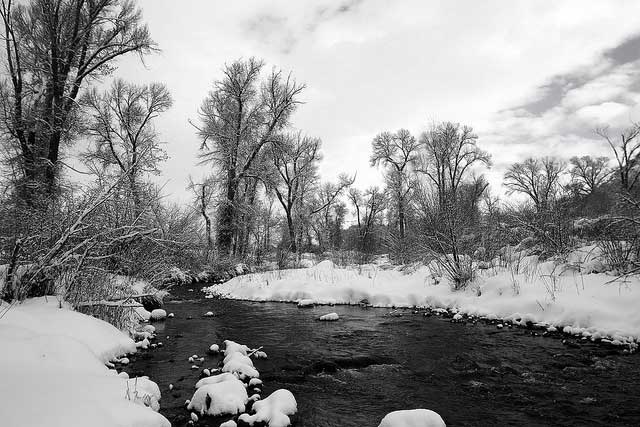“Walking the Line”

Mike Doughty photo
Wintertime cold changes the nature of things. Trout, of course, slow down a bit. It also changes the nature of a river. Rather than an eternal force of erosion and motion, it becomes a prisoner of entropy, channeled and capped and trapped within its banks by its only natural enemy: ice.
This in turn changes the nature of fishing, and of the angler. At least of this angler. Other times of the year, I could almost be called a dry fly snob. Here in the Upper Great Lakes, I’ve come to really love fishing dry flies on our sandy rivers for brown trout during the summer big-bug hatches. I usually don’t bother with other kinds of trout fishing. But by late January, with other fisheries locked in ice, the surreal prospect of a trout in hand is motivating. Do they still exist?
So I bothered to catch a brown trout the other day. It was easy, once I had huffed my way along an ice-crusty half-mile trail, alternatively post-holing and slipping, and once I’d slid across the sketchy shelf ice and waded into position. I watched a ten-inch trout decisively and slowly move off the bottom and take my fly, the weighted lead in a two-nymph rig, with his little white mouth. A few moments later, my hand was wet and very cold–well, as cold as the fish–and he lethargically swam out of the net back to his hole. It was fun, but not exactly transcendent dry fly bliss.
In the days since I’ve been thinking about the lines that we anglers like to draw in our angling careers. My dry fly preference is such a line, and I must admit that some part of me considers it a “better” way to catch trout. Maybe it comes from my early reading of Norman Maclean or The Curtis Creek Manifesto. In any case, to me, dry fly fishing seems more sporting, more honorable, more natural.
Of course that’s all bullshit. The fish doesn’t care exactly how you jam a hook in its face. But the line’s drawn there in my mind, nonetheless, and staying behind it most of the time enriches my angling experience. That line, and others like it, are some of the best things about fly fishing: issues to take stands on and argue about that don’t really matter. These days especially, such things are a welcome relief.
Like whether or not you’re disqualified from the sport of fly fishing by floating a “strike indicator” and a heavily-weighted fly right alongside the boat as you drift through an ultra-fertile tailwater. Or for fishing that same fly on a tight line to a pocket of fish at your feet. I’ve done both because they work–but it’s hard to argue that I was “using a weighted fly line to carry a weightless fly,” which is, of course, a classic definition of the sport. And to me, the fish caught those days just don’t feel the same, even if in numbers or size they are extraordinary.
I have a guide friend in Michigan who scorns the purist attitude. He will do “whatever it takes” to catch fish, and is proud of it. Dries, nymphs, streamers, egg flies, pegged beads. Makes sense, especially with paying clients in the boat. He is undoubtedly a better angler than I am, with plenty of extra tools in his box. But if he were being honest, he’d still have to admit that he draws a line. It’s shifted down a bit from mine, but it’s still there. You won’t find Styrofoam worm tubs or Rapalas in his boat.
Each of us has a reason why we picked up a fly rod in the first place, and that reason is almost never “because it’s the most effective way to harvest fish.” Something about the blending of artistry and sport speaks to us. And that’s good. It means that, even to the wizened river guide, there’s something in the act more important than catching fish. Arguing and debating about methods and tactics–the lines we’ve each drawn–is fun and good for the sport. But the really important thing is that we have them.
So here’s a winter challenge: think about where you’ve drawn your fly fishing lines. Own them and their contradictions. And then challenge them. Sneak over it them a bit and learn something. Keep a legal trout for dinner. Fish for carp. Leave your dry-fly box or nymph box behind. On your way home, stop at the local fly shop, buy a few leaders or something, and instead of talking politics, ask the old-timer at the fly bins what he thinks about using a #10 barrel swivel in an indicator rig.











